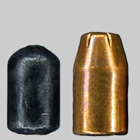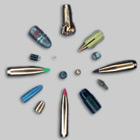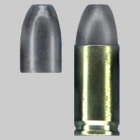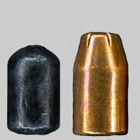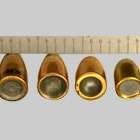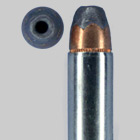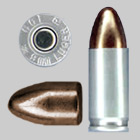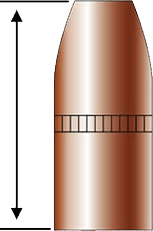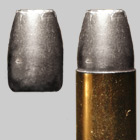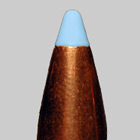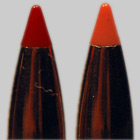Home | Glossary | Resources | Help | Contact Us | Course Map
Archival Notice
This is an archive page that is no longer being updated. It may contain outdated information and links may no longer function as originally intended.
Composition
Bullet composition refers to the materials used in the fabrication of a bullet.
Basic types of compositions include the following:
- Solid Bullets.
- Swaged and cast lead.
- Single metal (e.g., steel, aluminum, zinc, copper alloys, and brass).
- Bullet Jackets.
- Jacketing metals (e.g., copper alloys, brass, aluminum, nickel, and steel).
- Bullet Cores.
- Heavier metals (e.g., lead and steel).
- Bullet Coatings.
- Sabots.
- Plastic sleeve or adaptor surrounding a subcaliber bullet that allows it to be fired in a larger caliber firearm. The projectile never directly touches the barrel, and the sabot typically falls away after firing. Because the bullet never directly engages the barrel, rifling impressions will not be impressed on the bullet but rather the sabot.
Jacket Type
Bullet jackets may be fabricated in a number of configurations:
- Full metal jacket - encloses the entire bullet, with the exception of the base. Normally used for military purposes, these bullets are also known as full jacketed, full patch, full metal case , and ball ammunition.
- Semijacketed partially encloses the bullet with the exception of an exposed soft point or a hollow point.
- Total metal jacket fully encloses a bullet core.
Properties
Magnetic
To determine if a bullet is ferrous, a magnet can be used.
Length
Length information may be of limited value because fired bullets are slightly longer than unfired bullets. To ensure good obturation at the base of the bullet, bullets have a diameter slightly larger than the barrel through which they are fired. When the bullet is fired, it is lengthened by extrusion. A general similarity between a fired evidence bullet and a reference standard is sufficient to establish a general consistency in length.
| Note: |
| Damaged, mutilated, and deformed bullets may not yield accurate measurements. |
Color and Finish
The color of materials used in bullet construction or the color of any coating may be helpful in searching reference files for a particular type of ammunition. Although there are many specialized color-coded bullets (generally of military origin), they are only occasionally or rarely found in forensic casework.
Examiners must be aware of bullet color coding because there are several safety implications. Coding conventions may differ between countries and even within a given country.
Examples include the following:
- Armor-piercing bullets are designed to pierce metal. They usually contain a hardened core or are completely composed of a substance other than lead or lead alloy.
- Exploding bullets contain a primer or other explosive and are designed to explode upon impact.
- Frangible bullets are designed to disintegrate upon impact with a hard surface in order to minimize ricochet.
- Incendiary bullets contain a chemical compound that ignites upon impact, starting a fire.
- Tracer bullets contain a burning compound in the base to permit observation of bullet flight.
Additional Online Courses
- What Every First Responding Officer Should Know About DNA Evidence
- Collecting DNA Evidence at Property Crime Scenes
- DNA – A Prosecutor’s Practice Notebook
- Crime Scene and DNA Basics
- Laboratory Safety Programs
- DNA Amplification
- Population Genetics and Statistics
- Non-STR DNA Markers: SNPs, Y-STRs, LCN and mtDNA
- Firearms Examiner Training
- Forensic DNA Education for Law Enforcement Decisionmakers
- What Every Investigator and Evidence Technician Should Know About DNA Evidence
- Principles of Forensic DNA for Officers of the Court
- Law 101: Legal Guide for the Forensic Expert
- Laboratory Orientation and Testing of Body Fluids and Tissues
- DNA Extraction and Quantitation
- STR Data Analysis and Interpretation
- Communication Skills, Report Writing, and Courtroom Testimony
- Español for Law Enforcement
- Amplified DNA Product Separation for Forensic Analysts


